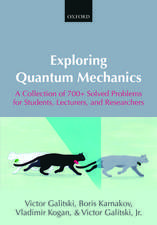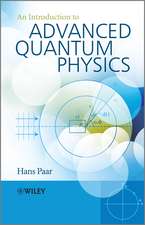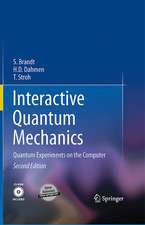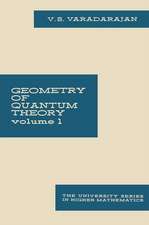Paradox Lost: Images of the Quantum
Autor Philip R. Wallaceen Limba Engleză Hardback – 25 apr 1996
| Toate formatele și edițiile | Preț | Express |
|---|---|---|
| Paperback (1) | 245.89 lei 22-36 zile | |
| Springer – 17 sep 2011 | 245.89 lei 22-36 zile | |
| Hardback (1) | 278.42 lei 22-36 zile | |
| Springer – 25 apr 1996 | 278.42 lei 22-36 zile |
Preț: 278.42 lei
Nou
Puncte Express: 418
Preț estimativ în valută:
53.28€ • 55.76$ • 44.34£
53.28€ • 55.76$ • 44.34£
Carte disponibilă
Livrare economică 10-24 martie
Preluare comenzi: 021 569.72.76
Specificații
ISBN-13: 9780387946597
ISBN-10: 0387946594
Pagini: 166
Ilustrații: XII, 166 p.
Dimensiuni: 156 x 234 x 18 mm
Greutate: 0.42 kg
Ediția:1996
Editura: Springer
Colecția Springer
Locul publicării:New York, NY, United States
ISBN-10: 0387946594
Pagini: 166
Ilustrații: XII, 166 p.
Dimensiuni: 156 x 234 x 18 mm
Greutate: 0.42 kg
Ediția:1996
Editura: Springer
Colecția Springer
Locul publicării:New York, NY, United States
Public țintă
Popular/generalCuprins
1. Introduction.- 2. Beyond the Ether.- 3. Introduction to Quantum Mechanics.- 4. Analysis of the Photoelectric Effect.- 5. De Broglie and Electron Waves.- 5.1. Amplitude, Phase, and Interference.- 6. The Wave Function and Feynman’s Two-Slit Experiment.- 7. The Pauli Exclusion Principle: the Identity of Particles.- 8. The Schrodinger Wave Equation and the Hydrogen Atom.- 9. Critique of the Pointlike Electron.- 10. Complementary Attributes and the Uncertainty Principle.- 11. An Illustration: Polarized Light.- 12. Heisenberg and Measurement.- 13. More on Measurement.- 14. Further Reflections on the Bohr-Peierls Interpretation.- 15. Toward the Dirac Viewpoint.- 15.1. The Dirac Version.- 16. Feynman’s Path Integral Method.- 17. Are Fields All?.- 18. A Visit with Photons: Identity and Flexibility.- 19. Can Wave Packets Be Particles?.- 20. The Quantum Stellar Interferometer of Hanbury Brown.- 21. About the Delayed-Choice Experiment.- 22. The Illusion of Superluminal Signaling.- 22.1. Davies’ “Split Box” and Wave Function Collapse.- 22.2. The Modified EPR Experiment with Photons.- 23. The Meaning of Bell’s Theorem.- 24. Symmetry and Point Particles.- 25. The Quantum Mechanics of Multiparticle Systems.- 26. Atoms, Molecules, and the Periodic Table.- 27. Chemists, Pictures, and Molecular Architecture.- 28. Carbon and the Structure of Organic Molecules.- 29. Quantum Behavior in Macroscopic Systems: Beyond Wave Functions.- 29.1. Elementary Excitations as Quanta.- 30. More on Phases: The Effect of Magnetic Fields.- 31. Macroscopic Quantum Phenomena.- 31.1. Laser Light.- 31.2. Superconductors.- 31.3. Superfluid Liquid Helium.- 32. Collective Oscillations in Solids.- 33. Beyond the Frontier: Nonclassical Properties.- 34. Some Reflections on “Reality”.- 35. Reality andOther Sciences.- 36. A Final Perspective.
Recenzii
"I recommend this book to physicists, especially quantum mechanics lecturers and their students. You will enjoy it as I did." Australian & New Zealand Physicist
FROM THE REVIEWS:
ZEITSCHRIFT FUR PHYSIKALISCHE CHEMIE
"Within the bulk of books introducing non-professionals to quantum physics that of Wallace certainly belongs to the most reasonable ones.”
AUSTRALIAN & NEW ZEALAND PHYSICIST
"The author is always very perceptive, and often presents things from a slightly nonstandard viewpoint, or with considerable clarity…The various sections of the book are well and pertinently referenced…I recommend this book to physicists, especially quantum mechanics lecturers and their students. You will enjoy it as I did.”
FROM THE REVIEWS:
ZEITSCHRIFT FUR PHYSIKALISCHE CHEMIE
"Within the bulk of books introducing non-professionals to quantum physics that of Wallace certainly belongs to the most reasonable ones.”
AUSTRALIAN & NEW ZEALAND PHYSICIST
"The author is always very perceptive, and often presents things from a slightly nonstandard viewpoint, or with considerable clarity…The various sections of the book are well and pertinently referenced…I recommend this book to physicists, especially quantum mechanics lecturers and their students. You will enjoy it as I did.”
















